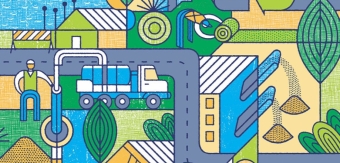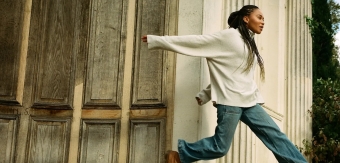With the COVID-19 outbreak showing no signs of giving up, more and more professionals in the creative industry have been struggling with mental health, with 67% of people feeling now more anxious than ever, according to Anxiety UK.
The mental health awareness conversation has luckily been on the rise in the past few years, and the industry has made huge progress to strengthen mental wellbeing in the workforce. How is the creative industry coping with mental health issues these days? What are the new challenges, and what are team leaders doing to overcome them?
We got in touch with some of our Annual 2020 nominees for Creative Influencer of the Year to ask them more about how they have been dealing with mental health issues in the team. This article includes quotes and answers by the following creative leaders:
- Ryan Wylie, European Product & Experience Design Lead at Ogilvy, VMLY&R and GTB
- Pip Hulbert, CEO of Wunderman Thompson UK
- Tony Pipes, ECD at ITV Creative
- Rania Robinson, CEO & Partner of Quiet Storm
- Russ Lidstone, CEO of the Creative Engagement Group
- Tracey Shirtcliff, Founder & CEO of the Virtu Group
- Richard Pearson, Creative Director of BJL Group
Lockdown and mental health: what are the new challenges?
Being a creative professional during a worldwide crisis can be challenging as it is, and it is no wonder that the lockdown has introduced a series of new challenges and obstacles for mental wellbeing. These range from feelings of guilt to anxiety, fear of losing one’s job and financial pressure, as well as the occasional big job coming through and having to deal with it in an unfamiliar setting.
“We’ve had people feeling guilty because they are working whilst others cannot, or because they are juggling home/work and have questioned their own effectiveness,” CEO of the Creative Engagement Group Russ Lidstone says. “And all this also sat heavily against an extraordinary context of upheaval, both politically and societally – especially in the US.”
Feelings of loneliness and isolation are amongst the highest contributors to poor mental health
The lack of stimuli also hasn’t helped. Artist/writer’s block is very much alive these days, and this feeds our self-doubt, amplifies frustrations and stress, making things even more challenging for struggling professionals.
According to CEO of Wunderman Thompson UK Pip Hulbert, Social distancing and lockdown also forced us to “stay far from some of our coping mechanisms,” such as the ability to exercise or socialise. In this climate of unpredictability, life has become more constrained for most of us, undermining our mental wellbeing.
In a way, however, global lockdown restrictions have also made us more human. As Engine CCO Billy Faithfull said in one of our recent interviews, we have been welcomed into the lives of our coworkers, meeting their significant others, pets, children and close relatives. Conversations have become more lighthearted. Everything feels more personal.
And if it is true that we creatives tend to have heightened empathy and sensibility, this must mean something positive for our mental health.
Are creatives more vulnerable to mental health issues in lockdown?
As a creative, you may be a natural born introvert. If not, some traits of your character would probably make you lean towards the introvert side. You may even be comfortable with the current situation – after all, is there anything better than locking yourself up in your own bubble, working on your own work, as autonomously as you’ve ever wished?
And yet, you do miss that team vibe from back in the office. You do miss your coworkers, the occasional chat with the colleague from another department. If you are a freelancer, you do miss that vibe of going out with your friends, your network, your connections. You miss the ‘old normal.’
We will have a chance to dive deeper into the ties between mental health and creative personalities soon, but it is a topic worth mentioning now. According to Quiet Storm CEO and partner Rania Robinson, creatives “tend to draw the world in a lot more and often over-analyse things. Their imaginations can take them to all sorts of places, sometimes dark and scary.”
In addition, creatives are by their nature the very definition of over-thinkers, according to ECD at ITV Creative Tony Pipes. “Most of our minds are never off the clock and it can be exhausting.” We also spend most time craving approval and recognition, especially being part of an industry that is founded on ideas, feedback, approval and rejection. As a writer, I know how hard it is not to take feedback personally. But we still need to endure.
As creatives in the industry, we spend most time craving approval and recognition
We should be careful not to lock ourselves up in our ivory tower of design and creativity, however. Though there are some elements that can appear heightened during these times, WPP European product and experience design lead Ryan Wylie believes that every individual and every career path will have its own unique set of challenges.
It is also not just a matter of being creative or not. The developers at the Virtu Group, led by Tracey Shirtcliff, are introvert by stereotype, and it appears that introverts are generally more happy with their alone time right now. It is extroverts she is more concerned about: “I see the extroverts who are used to getting their energy from people are struggling more – the team in the front line with clients especially, and those on pitches. They feel the responsibility of holding up the business in the difficult time.”
And of course, leaders feel that kind of pressure on their backs just as much.
What can leaders do to help their team’s mental wellbeing?
Though the creative leaders we interviewed all approached the challenge in different ways, there was one common element to all their responses – clarity and openness of communication.
Being transparent and honest, not only with your team but also with yourself, can make a huge difference to the business and everyone’s overall mental wellbeing. And it starts with recognising your own vulnerabilities.
“A leader should be sharing their own struggles with the team as well. Just because they’re a leader doesn’t mean they aren’t also affected. It’s important for the team to see this and understand everyone experiences the same mental challenges from time to time, and it’s okay to share,” European product & experience design lead at WPP, Ryan Wylie, says. Through openness of communications and transparency, leaders can cultivate a psychologically safe environment for everyone, including themselves.
Being involved is key. Regular check-ins, individual check-ups, relaxed moments during the week to have team meetings and keep that team spirit alive, even while socially-distanced. It will all make a huge difference.
A leader should be sharing their own struggles as well.
For those businesses able to do it, investing in resources is just as recommended and important. Pip Hulbert and Wunderman Thompson UK have collected a range of resources for the team to use, from readings on remote working to educational videos and mindfulness exercises for the whole agency. Games and Friday company meetings have helped the team keep a lighthearted mood, and in turn, we can safely assume that the team has been just as (if not even more) productive as before lockdown.
While a prime example, fortunately Wunderman Thompson UK is not the only one. According to Russ Lidstone, “many businesses have realised early on the impact this pandemic could have on mental wellbeing. We have worked hard and continue to work hard to ensure our team is aware of the best practice, have given themselves downtime, stepped away from their desks for air and exercise and where possible tried to take time away. We’ve also been clear that flexible working and managing life stuff (like home-schooling) is necessary and should be a priority for our team.”
Share, communicate, be involved. It’s the only way you can help the team remain sane… just as you can help yourself.
How can I take care of my mental health during lockdown?
Whether you’re a leader or not, the lockdown has likely brought you closer to your loved ones, either home or at work. While you’re caring for others, it’s way too easy to lose track of your own self. But you should take care of your mental health as well – again, whether you are an employee, a freelancer or a leader.
Russ Lidstone is lucky enough to have a family to keep him company and a garden to switch off every once in a while. In addition to that, he’s also found it useful to revisit his old history graduate roots, reading up on some contemporary history and just generally doing what he likes the most.
And if you are caring for someone else, Tony Pipes has some advice for you too. “The best thing you can do for people is to let them know that you are going through the same. Share, talk and be open. I’ve seen my team suffering and they have seen me suffering, but we help each other, celebrate each other. With regular check-ins and a virtual open door, we are getting through it together.”
The best thing you can do for people is to let them know that you are going through the same
Show patience. “Some people are very concerned for their families, their livelihoods and their health,” founder & CEO of the Virtu Group Tracey Shirtfcliff says. “It’s not a one-size fits all. Take each person’s view with respect and work to understand how you can support them – and vice versa.”
Most of all, be resilient, yet open to sharing, as BJL creative director Richard Pearson puts it. “Creatives have to be resilient, it’s a must when the vast majority of ideas you come up with are never used or rejected. You need a mental toughness to keep going and to come up with new ideas or develop the ones you have, especially after a particularly tough present. But that doesn’t mean you should keep quiet if you are having problems.
“If you’re an agency leader or CD,” Richard concludes, “it’s important to understand the pressures that searching for great ideas and deadlines can have.”






